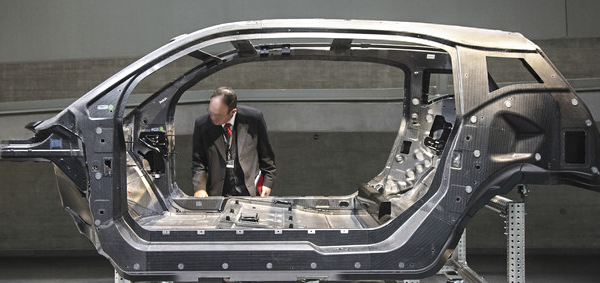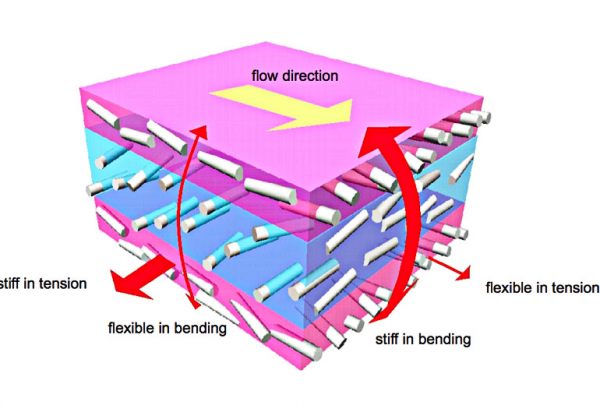Fiber Modeling for Long Glass Molding Developed by National Labs – Industry First
 Material innovation and lightweight fiber composites are transforming the global automotive industry. Short glass fibers (0.2 – 0.4mm) gave new strength to plastic automotive parts as early as the 1950’s. Today’s “laid up” (not injected or extruded) plastic carbon fiber sheet configurations are lightweighting racing and high performance vehicles: the Chevy Mi-ray Concept, the BMW i3, McLaren MP4-12C, the Audi-Voith Partnership, and Lamborghini’s composite core.
Material innovation and lightweight fiber composites are transforming the global automotive industry. Short glass fibers (0.2 – 0.4mm) gave new strength to plastic automotive parts as early as the 1950’s. Today’s “laid up” (not injected or extruded) plastic carbon fiber sheet configurations are lightweighting racing and high performance vehicles: the Chevy Mi-ray Concept, the BMW i3, McLaren MP4-12C, the Audi-Voith Partnership, and Lamborghini’s composite core.
But attempts modeling the flow of long glass fibers (10 – 13mm) into plastic parts have been a subject of complex research for years. During the last half decade, the Plastics Division of the American Chemistry Council (ACC) identified the importance of stronger lighter weight auto parts and has been working in collaboration with the Department of Energy (DOE) and the U.S. National Laboratories to refine and complete wide-ranging long glass fiber research vital to the successful adoption of these stronger thermoplastic combinations.
Newly achieved progress, research findings and recent “lessons learned” were presented in April 2012 at the Society of Automotive Engineers (SAE) World Congress by Michael Wyzgoski, Ph.D., a past GM R&D Group Leader and the former Polymers Group Manager for Delphi Research in Detroit, now a consultant to the plastics industry ACC Automotive Team.
“Generally, the longer the fiber a material possesses, the better the part’s strength and stiffness,” said Dr. Wyzgoski. “But, longer fiber materials flow very differently from all prior models, so “a new model needed to be developed to predict a part’s strength or stiffness. This was a major research challenge that remained unsolved for years. At first, we were shooting in the dark,” Wyzgoski said.
The ability of automotive designers to dependably predict the modulus, impact, strength, fatigue and stiffness of various-sized long glass fiber-reinforced thermoplastics depends on reliably modeling the fiber sizes, the fiber orientations and the relative fiber positioning within each part. “Without these crucial components, we cannot create models that predict reliable performance,” said Dr. Wyzgoski, “My message to engineers is this: You may not think it’s possible, but you can do this now! You can model long glass fiber parts accurately and dependably. These confirmed calculations are now added to newer versions of Moldflow® computer design software plus the backup research is there.” Other software packages such as Moldex also have indicated a capability for predicting fiber architecture in parts.
“Lightweight materials with predictable strength are essential to producing more fuel efficient cars for the 21st century. Continuing research like this is helping global automotive companies utilize plastics, composites and other lightweight materials which can help meet that goal.” said Steve Russell, vice president of plastics at ACC.
As early as 2006 Oak Ridge National Labs and the Pacific Northwest National Labs began groundbreaking research in long glass fiber thermoplastic parts molding. A staff member of ACC Plastics Division Automotive Team, Dr. Wyzgoski and Dr. Peter H. Foss of USCAR and GM were members of the industry research steering committee for the National Labs. Initial research funded by DOE was broad-based, significant and essential. Yet while this research was uniquely productive, it helped the ACC identify unforeseen additional research needs key to long-term success.
For example, the ACC is funding follow-on research at Virginia Tech, the University of Illinois, the University of Dayton Research Institute and Michigan State University. This research is utilizing the well-characterized specimens from the National Labs, which are then used for further testing at the universities under industry guidance. In fact, the plastics industry ACC Plastics Division continues financing similar research with Oak Ridge National Labs today.
Persistence paid off when laboratory examinations of cross-sections (or, orientation tensors) of long fiber moldings showed the fibers were arranged in very different unique patterns. These microstructural patterns are of great significance since they dictate the mechanical properties of the part.
Industry articulated university research detailed the importance of:
- The fiber lengths generated by the molding process
- The fiber orientation
- Fiber distribution throughout the part thickness (balance of fibers in the core versus the shell of the part will define the anisotropy or, the flow versus crossflow properties).
Just as the fiber orientation and fiber lengths in traditional short fiber reinforced plastics determine properties such as strength and elastic modulus, so too, these unique long fiber orientations and lengths provided the key to predicting improved mechanical performance.
The National Labs validated that these three important components could be predicted by process models for long fiber reinforced plastics for the first time in plastics engineering. This opened the door for developing accurate predictive modeling of the mechanical performance of these materials both at the National Labs and universities.
“Before a part can be designed to resist mechanical “multi-axial” [multi-directional] forces and be accepted for a new application, engineers want to know that the strategic fundamental fiber microstructure and associated mechanical performance were accurately modeled,” according to Wyzgoski. With these new insights and in collaboration with the National Labs, new long fiber injection molding process models were created and confirmed by Prof. Charles L Tucker III, of the University of Illinois at Urbana-Champaign, the original researcher responsible for providing Moldflow® short fiber reinforced plastics modeling software.
“Engineers need to know these calculations are available in Moldflow® and other software today. Unavailable before this year, plastics engineers now have the process modeling capability for long fiber plastic part calculations in a pull-down menu,” asserts Wyzgoski. This will enable a multitude of composite micromechanics models to be developed for predicting mechanical performance. Some of these have already been developed at the National Labs and are being incorporated with the process models in Moldflow®.
This collaborative plastics industry research will bypass the “make it and break it” trial-and-error testing on plastic parts that would have delayed or inhibited the adoption of fiber filled plastics for years, potentially limiting plastics from these competitive arenas. In addition, this research can be applied to other market sectors.
Partially as a result of the plastics industries’ and the National Labs’ successful research in this area, the Department of Energy (DOE) recently announced further grants to be awarded for development of long carbon fiber process models (as opposed to long glass fiber, discussed here). Carbon fiber though more expensive at this time, holds even greater promise in plastic composites because it weighs less than glass and is an even stronger and stiffer fiber.
Dr. Wyzgoski will further demonstrate how the latest research, including test methods for comparing mechanical properties of long fiber thermoplastics at high strain rates and fatigue of fiber filled plastics is now available and ready to be used by plastics engineers in automotive and other industries.
